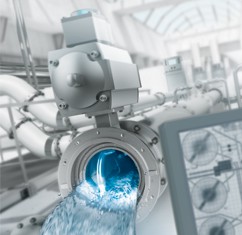 Festo > How to best optimise your application using Festo products
Festo > How to best optimise your application using Festo products
Electroquiphas years of experience delivering answers to factory automation conundrums using Festo pneumatics, as a nutraul progression we have began to effectively implementing products and systems to the process end of industry. With Festo it is possible to lower set up costs and operating expenditure in some cases by as much as forty percent.
By selecting the most suitable Festo components and systems it can increase the life of production facilities and lower the number of rejects, therefore improving productivity.
At Electroquip we have the know how and experienece to help combat most process requirements. For example we solved a problem at a toiletries manufacturer; they were losing high quantities of goods when changing from one type of production to another. As there were a high number of different products it led to smaller quantities of every product. The pipes needed cleaning after every shift changeover which meant millions of pound in losses inturn meaning long term costs were up. With Festo we found solutions for this by suggesting that they use a Festo ball valve distribution manifold which could be used for more than 20 tanks found in several perfumes. We were able to come up with an answer quickly producing a 3D-CAD model, as well as a prototype model before finalising the design.
It is not just the configuration and dimensioning of the valves utilized to distribute the various media that impact the success of cleaning operations. To gain far greater efficiency you need to manage the valves with the correct timing. Therefore, we looked at other ways to make the factory run more efficiently and installed the integrated- function valve terminal CPX/MPA inside the control cabinet next to the valve node guarantees interaction between all components and control of the process. By using Festo MPA gives each of the quarter turn actuators and ball valves centrally with compressed air. The built in fieldbus node also gives a link to the production control system.
The benefits to using a CPX/MPA valve terminal are:
They are plug and play.
They make sure that the valve node guarantees interaction between all of the components and control process.
Easy to install.
Cheaper to run in the long term as it lowers cleaning expenditure.
They are much more reliable.
Reduced leaks due to less connection points.
Less inspections and repairs needed.
Other examples where Festo helped improve reliability of the water supply in the Philippines. Festo experts suggested that the CPX/CEC valves would help them save money. They needed to know the status of their feeding pump station over 20km. As they had to send staff to check them, it was costly and central water reservations over flowed. Festo experts came up with using CPX/CEC valve. This meant that the status of the pumps could be monitored wirelessly in the central control room and the CPX/CEC valve could also have fully automatic control over the feed pumps. All of the ten feed pumping stations became equipped with the automation platform CPX as a slave. Antennas then send the information from the CPX to the control room for further processing by Festo CPX-CEC in the role as a master PLC.
The benefits of using a Festo CPX/CEC valve:
Monitoring can be done wirelessly.
You can have full control of the system.
You have all the important information that you need at your fingertips.
Saves money as you do not need people to physically monitor what you want to control
Festo experts also suggested that they use the pneumatic quarter turn actuator DAPS800 combined with positioners. The advantages of this are that it gives efficient monitoring and control of the amount of water distributed based on the customer’s needs and available resources.
For more information on CPX/CEC valves or any Festo products talk to the Festo experts at Electroquip.
